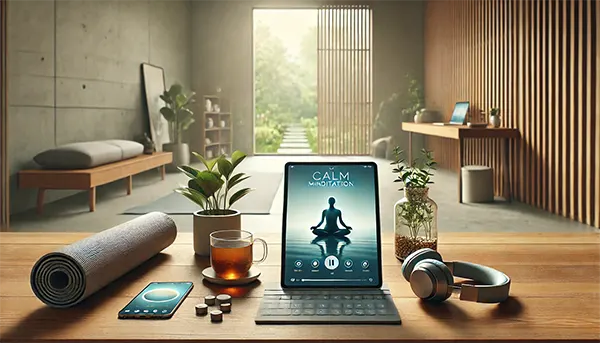Technologies of Silence: How Digital Tools Can Promote Mindfulness

In an age dominated by constant digital noise and distraction, the pursuit of mindfulness has become more than a trend — it is a necessity. While digital technology has long been blamed for decreasing our attention span and disconnecting us from the present, recent innovations are turning the tide. With the emergence of tools specifically designed to foster mental clarity, the intersection between tech and tranquillity has never been more relevant.
Digital Mindfulness Tools for Everyday Use
Mindfulness no longer requires a remote mountain retreat. Today, a variety of digital tools are helping users integrate awareness into their daily routines. Mobile applications such as Headspace, Calm, and Insight Timer provide guided meditations, sleep aids, and breathing exercises directly on smartphones. These apps offer structured content for both beginners and experienced meditators, making it easier to maintain a consistent practice.
Wearable technology also contributes to mindfulness. Devices like the Apple Watch or Fitbit include features that remind users to pause and breathe. The integration of heart rate monitoring allows these tools to suggest relaxation exercises when stress is detected, reinforcing the habit of checking in with one’s mental state.
Moreover, browser extensions like Momentum or Mindful Browsing are designed to introduce calm into workspaces. By replacing typical homepages with serene imagery and thoughtful quotes, they reduce online clutter and refocus the user’s attention. These tools promote brief but meaningful pauses throughout the day.
The Role of Sound and Silence in Digital Design
Sound design in apps and devices has taken a significant turn toward minimalism. Developers now focus on soft tones, ambient music, and silence to promote emotional balance. For instance, meditation apps use carefully crafted soundscapes — from rain to Tibetan bowls — to ease users into a relaxed state without overstimulation.
In some tools, the absence of sound is the most powerful feature. Silence, once considered a lack of input, is now a conscious design choice. Features like ‘Do Not Disturb’ modes or digital wellbeing settings on Android and iOS devices allow users to embrace quiet as part of their daily routine.
Digital environments, including websites and apps, are also adopting “calm design” principles. These minimise intrusive notifications and prioritise clean, distraction-free interfaces. The idea is simple: reduce noise to improve focus and emotional wellbeing.
Mindfulness in the Workplace through Digital Innovation
With remote work becoming the norm for many, digital mindfulness has entered the corporate sphere. Employers increasingly provide access to wellness platforms such as Balance or Ten Percent Happier, supporting employees’ mental health. These apps offer targeted sessions for stress reduction, productivity, and work-life balance.
Task management tools like Notion or Todoist have integrated features that align with mindful productivity. Features such as focus timers, priority settings, and visual progress trackers help users maintain attention on one task at a time, reducing cognitive overload and burnout.
Virtual reality (VR) is also gaining ground. Platforms like Tripp or Maloka use immersive environments to guide users through mindfulness journeys. These experiences replicate the serenity of natural spaces, offering meditative escapes from high-stress digital workplaces — right from a headset.
Creating Mindful Workflows with Technology
Mindfulness at work is not just about meditation breaks; it’s about designing workflows that reduce chaos. Calendar apps now integrate “focus time” features, automatically blocking off periods without meetings or interruptions. These simple additions help workers regain control over their day.
Some companies implement team-wide “quiet hours,” during which internal communication tools like Slack are paused. These hours are digitally enforced, signalling a shift towards respecting mental space in a hyper-connected work culture.
Even email clients are evolving. Tools like Superhuman and Hey prioritise clarity and intentionality, minimising the overwhelm of digital communication. Smart filtering and reply scheduling features allow users to manage communication mindfully rather than reactively.

Challenges and the Future of Digital Mindfulness
Despite the growth of mindful technology, challenges remain. Over-reliance on digital tools for mindfulness may create dependency, and paradoxically, more screen time. It’s essential to balance the use of digital aids with offline practices, encouraging users to set boundaries even with “good” tech.
Privacy is another concern. Many mindfulness apps collect personal health and emotional data, raising ethical questions about how such sensitive information is used. Developers are increasingly held accountable to ensure data transparency and user consent.
Looking ahead, AI and machine learning are expected to enhance personalised mindfulness. Future tools could adapt to emotional states in real time, providing targeted interventions. However, this evolution must prioritise human values, ensuring technology serves as a tool for inner awareness rather than a replacement for it.
Digital Balance as a Lifestyle Choice
Mindfulness is not a quick fix but a continuous practice. Integrating technology thoughtfully can support this journey, but it requires conscious effort. Users must evaluate which tools genuinely help and which ones add to digital clutter.
Educational institutions and families are beginning to introduce mindful tech habits early. Screen time management apps for children and teens are encouraging more intentional digital usage, fostering lifelong digital wellbeing skills.
Ultimately, the future of digital mindfulness depends not only on technological advances but also on user awareness. When digital tools are used to create space rather than fill it, they become allies in cultivating a more present, intentional life.
